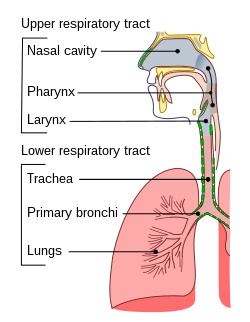Tracheobronchial
| Respiratory tract | |
|---|---|

Conducting passages
|
|
| Details | |
| System | respiratory system |
| Identifiers | |
| FMA | 265130 |
|
Anatomical terminology
[]
|
|
In humans, the respiratory tract is the part of the anatomy of the respiratory system involved with the process of respiration. Air is breathed in through the nose or the mouth. In the nasal cavity, a layer of mucous membrane acts as a filter and traps pollutants and other harmful substances found in the air. Next, air moves into the pharynx, a passage that contains the intersection between the esophagus and the larynx. The opening of the larynx has a special flap of cartilage, the epiglottis, that opens to allow air to pass through but closes to prevent food from moving into the airway.
From the larynx, air moves into the trachea and down to the intersection that branches to form the right and left primary (main) bronchi. Each of these bronchi branch into secondary (lobar) bronchi that branch into tertiary (segmental) bronchi that branch into smaller airways called bronchioles that eventually connect with tiny specialized structures called alveoli that function in gas exchange.
The lungs which are located in the thoracic cavity, are protected from physical damage by the rib cage. At the base of the lungs is a sheet of skeletal muscle called the diaphragm. The diaphragm separates the lungs from the stomach and intestines. The diaphragm is also the main muscle of respiration involved in breathing, and is controlled by the sympathetic nervous system.
...
Wikipedia
